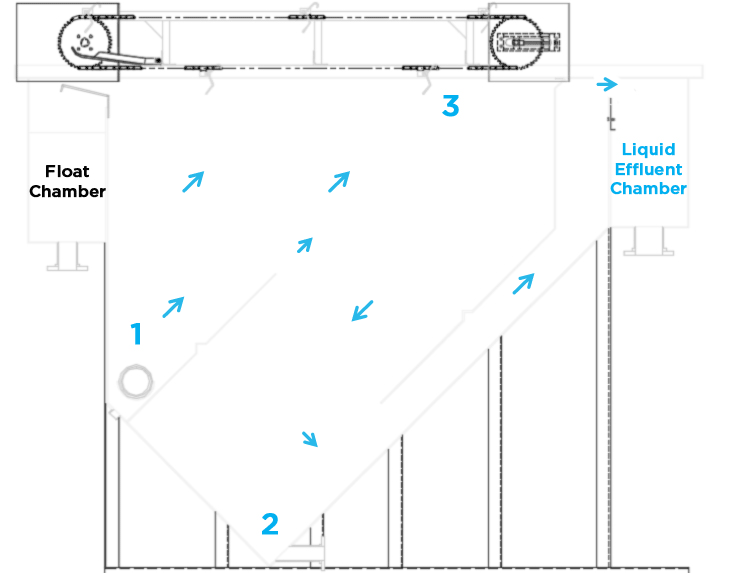The Ellis Dissolved Air Flotation (DAF) wastewater system is a time-tested technology that has been installed in hundreds of locations. The first generation of the Ellis DAF was manufactured and installed in 1973 in Chicago. During the past six decades, Ellis engineers have made continuous improvements optimizing air bubble generation, rapid rise flotation rates, and adjusting surface area to meet performance goals. Ellis currently provides three different DAF designs to meet the challenges of our customer’s wastewater and achieve their goals. We offer Rectangular DAFs, Square DAFs, and Compact DAFs. Our basic designs provide solutions based on pollutant loadings and allocated space.
The Ellis DAF surface skimmer design is unique to our systems to maximize solids removal and minimize water in the sludge. The design of the surface skimmer minimizes excessive wear and tear on the skimmer assembly operating in a Ferris wheel motion. This design minimizes wear and tear on the chain links, gears and motor.
Each dissolved air flotation device is shipped prewired and ready for operation. Once power is connected to the DAF controls, all the customer has to do is bring the wastewater feed and chemicals into the system and the separation process begins.
DAFs efficiently remove fats, oils, and greases (FOG) and suspended solids (TSS) from the wastewater. It is also capable of reducing insoluble biological oxygen demand (BOD) and chemical oxygen demand (COD). FOG and TSS removal rates in excess of 95% are common. Some installations report as much as a 99% reduction.
HOW IT WORKS

- Chemically pretreated wastewater enters the DAF flotation cell. Chemical pretreatment is used to break emulsified waste streams so that the particulates can floc together to form a surface sludge blanket. Chemical pretreatment varies for every application.
- Ellis DAF units use optimally designed microbubble generator pumps. These microbubbles rapidly float the floc particles to form the surface sludge blanket onto the surface of the flotation cell.
- The floating solids are skimmed towards the front of the DAF and collected in a solids chamber. The effluent flows to the back side of the DAF under a baffle and into a separate liquid effluent chamber before leaving the unit.
Dissolved Air Flotation (DAF) Standard System
- Materials of Construction – Carbon Steel
- Protective Coatings – Coal Tar Interior Protective Coating. These can minimize the adverse effects often associated with elevated chloride concentrations, corrosive and abrasive materials. Polyurethane enamel paint is used on the exterior surface.
- Aeration System – Microbubble Aeration Pump System with a uniquely designed impellor generates the proper microbubble size of 20 to 30 microns. No air compressor system needed.
- Surface Skimmers – The pivoted surface skimmer design is unique to the Ellis DAF systems. The skimmer paddles are pivoted to use a ferris wheel application removing pressure and unnecessary wear and tear on the skimmer assembly parts. The high torque motor, chain, and skimmer paddles last longer with minimal maintenance.
- DAF Controls – The DAF system is readily equipped with most monitoring controls. These include flow rate monitoring, liquid level indicators, and pH.
Dissolved Air Flotation (DAF) Optional Equipment
- Materials of Construction –304 and 316 Stainless Steel
- Chemical Reaction Tanks – Carbon Steel or Stainless Steel Design
- Tube Flocculator, PVC or Stainless Steel Design
- Wastewater FlowMeter
- Pumping package –Including Inlet, Outlet, &Sludge Removal Pumps and VFDs
- Solids Removal Auger
- Walkways and Guard Rails, Stairways or Ladders
- pH, Turbidity, Temperature, or Conductivity Monitoring Systems
- ChemicalFeedEquipment
- ControlPanel–ExplosionProof
- Freeze Protection–Thermal Heating and Extra Insulation.
- Effluent Weir Tanks–Final pH Adjustment and Flow Transfer to the Sewer.
Dissolved Air Flotation Applications
- Algae Removal
- Animal Food and Byproduct Processing
- Slaughterhouse Processing
- Meat Processing
- Dairy & Milk Processing
- Bakeries & Confectionaries
- Snack Food Processing
- Textile Finishing and Dyeing
- Energy Production Byproducts Treatment & Conditioning
- Food Packaging & Processing
- Groundwater Remediation
- Heavy Metal Removal
- Industrial & Commercial Laundries
- Industrial Floor Wash-down Solids Separation and Conditioning
- Oil & Petrochemical Production
- Natural Gas and Petroleum Fracking
- Preparation of Parts for Painting
- Pulp & Paper Production
- Steel Mill Production
- Storm Water Runoff
- Vehicle & Fleet Washing
- Pretreatment to reduce loading on downstream biological treatment systems
- Egg Processing
- Plastics Recycling
